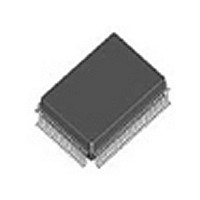AM53CF96KC/W AMD (ADVANCED MICRO DEVICES), AM53CF96KC/W Datasheet - Page 39

AM53CF96KC/W
Manufacturer Part Number
AM53CF96KC/W
Description
Manufacturer
AMD (ADVANCED MICRO DEVICES)
Datasheet
1.AM53CF96KCW.pdf
(76 pages)
Specifications of AM53CF96KC/W
Lead Free Status / RoHS Status
Not Compliant
Initiator Command Complete Steps
(Command Code 11H/91H)
The Initiator Command Complete Steps command is
normally issued when the SCSI bus is in the Status In
phase. One Status byte followed by one Message byte
is transferred if this command completes normally. After
receiving the message byte the device will keep the
ACK signal asserted to allow the Initiator to examine the
message and assert the ATN signal if it is unacceptable.
The command terminates early if the Target does not
switch to the Message In phase or if the Target discon-
nects from the SCSI bus.
Message Accepted Command
(Command Code 12H)
The Message Accepted Command is used to release
the ACK signal. This command is normally used to com-
plete a Message In handshake. Upon execution of this
command the device generates a service request inter-
rupt after REQ is asserted by the Target.
After the device has received the last byte of message, it
keeps the ACK signal asserted. This allows the device
to either accept or reject the message. To accept the
message, Message Accepted Command is issued. To
reject the message the ATN signal must be asserted
(with the help of the Set ATN Command) before issuing
the Message Accepted Command. In either case the
Message Accepted Command has to be issued to re-
lease the ACK signal.
Transfer Pad Bytes Command
(Command Code 18H/98H)
The Transfer Pad Bytes Command is used to recover
from an error condition. This command is similar to the
Information Transfer Command, only the information
bytes consists of null data. It is used when the Target ex-
pects more data bytes than the Initiator has to send. It is
also used when the Initiator receives more information
than expected from the Target.
When sending data to the SCSI bus, the FIFO is loaded
with null bytes which are sent out to the SCSI bus. Al-
though an actual DMA request is not made, DMA must
be enabled when pad bytes are transmitted since the
ESC uses Current Transfer Count Register (CTCREG)
to terminate transmission.
When receiving data from the SCSI bus, the device will
receive the pad bytes and place them on the top of the
FIFO and unload them from the bottom of the FIFO.
This command terminates under the same conditions as
the Information Transfer Command, but the device does
not keep the ACK signal asserted during the last byte of
the Message In phase. Should this command terminate
prematurely due to a disconnect or a phase change,
(before the Current Transfer Count Register (CTCREG)
decrements to zero), the FIFO may contain residual pad
bytes.
Set ATN Command (Command Code 1AH)
The Set ATN Command is used to drive the ATN signal
active on the SCSI bus. An interrupt is not generated at
Am53CF94/Am53CF96
the end of this command. The ATN signal is deasserted
before asserting the ACK signal during the last byte of
the Message Out phase.
Note:
The ATN signal is asserted by the device without this
command in the following cases:
Reset ATN Command (Command Code 1BH)
The Reset ATN Command is used to deassert the ATN
signal on the SCSI bus. An interrupt is not generated at
the end of this command. This command is used only
when interfacing with devices that do not support the
Common Command Set (CCS). These older devices do
not deassert their ATN signal automatically on the last
byte of the Message Out phase. This device does deas-
sert its ATN signal automatically on the last byte of the
Message Out phase.
Target Commands
Target commands are executed by the device when it is
in the Target mode. If the device is not in the Target
mode and a Target command is received the device will
ignore the command, generate an Invalid Command in-
terrupt and clear the Command Register (CMDREG).
A SCSI bus reset during any Target command will cause
the device to abort the command sequence , flag a SCSI
bus reset interrupt (if the interrupt is enabled) and dis-
connect from the SCSI bus.
Normal or successful completion of a Target command
will cause a Successful Operation interrupt to be
flagged. If the ATN signal is asserted during a Target
command sequence the Service Request bit is asserted
in the Interrupt Status Register (INSTREG). If the ATN
signal is asserted when the device is in an Idle state a
Service Request interrupt will be generated, the Suc-
cessful Operation bit in the Interrupt Status Register
(INSTREG) will be reset and the Command Register
(CMDREG) cleared.
Send Message Command
(Command Code 20H/A0H)
The Send Message Command is used by the Target to
inform the Initiator to receive a message. The SCSI bus
phase lines are set to the Message In Phase and mes-
sage bytes are transferred from the device FIFO to the
buffer memory.
Send Status Command
(Command Code 21H/A1H)
The Send Status Command is used by the Target to in-
form the Initiator to receive status information. The SCSI
bus phase lines are set to the Status Phase and status
bytes are transferred from the Target device to the Initia-
tor device.
If any select with ATN command is issued and the
arbitration is won.
An Initiator needs the Target’s attention to send a
message. The ATN signal is asserted before
deasserting the ACK signal.
AMD
39













